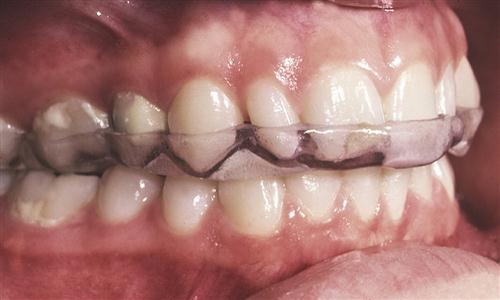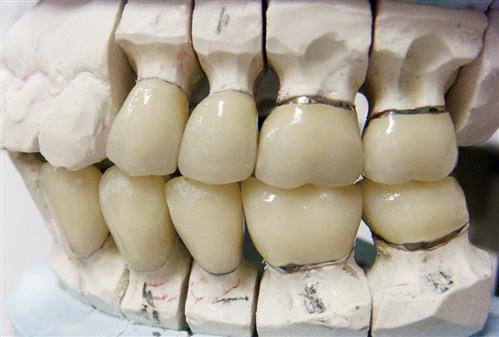General Considerations in Occlusal Therapy
“IF OCCLUSION IS FOUND TO SIGNIFICANTLY CONTRIBUTE TO A TMD, DENTISTRY IS THE ONLY HEALTH PROFESSION THAT CAN PROVIDE LASTING EFFECT. IF OCCLUSION IS NOT RELATED TO THE TMD, IT SHOULD NOT BE ALTERED OTHER THAN FOR RESTORATIVE OR ESTHETIC REASONS.”
—JPO
OCCLUSAL THERAPY IS any treatment that alters a patient’s occlusal condition. It can be used to improve function of the masticatory system through the influence of the occlusal contact patterns and by altering the functional jaw position. There are two types: reversible and irreversible.
Reversible occlusal therapy temporarily alters the occlusal condition and/or joint position but when removed returns the patient to the preexistent condition. An example would be an occlusal appliance (Figure 17-1). When the occlusal appliance is used, it creates a favorable alteration in the occlusal contacts and joint position. When it is removed, the patient’s original occlusal condition returns.
Irreversible occlusal therapy permanently alters the occlusal condition so the original condition cannot be recovered. An example would be selective grinding of the teeth whereby the occlusal surfaces are reshaped with the goal of improving the occlusal condition and orthopedic stability. Since this procedure involves the removal of enamel, it becomes irreversible and therefore permanent. Other forms of irreversible occlusal therapy are fixed prosthetic procedures and orthodontic therapy (Figure 17-2).
In the previous chapters reversible occlusal therapies (occlusal appliances) were discussed as treatment for many TMDs. In the following chapters the emphasis of occlusal therapy is on the irreversible types. Since irreversible occlusal therapy is permanent, it must be provided only when it is determined to be beneficial to the patient. There are two general indications that suggest the need for irreversible occlusal therapy: (1) treatment of TMDs and (2) treatment in conjunction with other necessary measures that will significantly alter the existing occlusal condition.
Treatment of Temporomandibular Disorders
Irreversible occlusal therapy is indicated when sufficient evidence exists that the primary etiologic factor creating a TMD is the prevalent occlusal condition and/or orthopedic instability. In other words, permanent improvement of the occlusal condition is likely to eliminate the functional disturbance of the masticatory system.
At one time it was felt that most TMDs were caused by malocclusion. With that belief, permanent occlusal changes became a routine part of the management of TMDs. Now that we have a better understanding of the complexity of TMDs, we appreciate that the occlusal condition is only one of five major etiologic factors that may lead to TMD (Chapter 7). Therefore permanent occlusal therapy is indicated only when significant evidence exists to support the conclusion that the occlusal condition is an etiologic factor. One should not routinely alter the occlusion without such evidence. Also, there are two ways in which the occlusal condition can become an etiologic factor in TMD: an acute change in the occlusal condition (altered sensory input) and orthopedic instability (plus loading) (Chapter 7). It is also important for the clinician to recognize that the occlusal management of these two conditions is quite different.
Sufficient evidence to change a patient’s occlusion is commonly derived through successful occlusal appliance therapy. However, the mere fact that the occlusal appliance relieves symptoms is not alone sufficient evidence to start irreversible occlusal therapy. As discussed in Chapter 15, the occlusal appliance can affect symptoms in several different manners. Effort must be made to determine which feature of the appliance is responsible for the elimination of the symptoms. When the multiple effects of occlusal appliance therapy are overlooked, an irreversible procedure such as selective grinding is likely to fail to eliminate the symptoms of the disorder. Since irreversible occlusal therapy is permanent, care must always be taken to confirm the need for these procedures before they are instituted.
Treatment in Conjunction with other Dental Therapies
Irreversible occlusal therapy is often indicated in the absence of any functional disturbance of the masticatory system. When a patients has a dentition that is severely compromised by broken, decayed, or missing teeth, there is a need to restore masticatory function. Restoring the dentition with operative procedures or with fixed and/or removable prostheses is a form of irreversible occlusal therapy. Even in the absence of any obvious TMD, the occlusal condition must be carefully restored to one that will promote and maintain health (Figure 17-3).
There is little doubt that providing occlusal therapy for patients with debilitated dentitions is an important service. This type of therapy, however, can lead to some very interesting and important questions regarding treatment. Imagine a 24-year-old woman who comes to the dental office for a routine checkup. She has no signs of functional disturbances of the masticatory system. Examination reveals, however, that she has a significant malocclusion. The question now posed is one of prevention. Should occlusal therapy be provided to improve the occlusal condition in an attempt to prevent any future TMD? Many prominent dentists would suggest just that. Yet at this time there is no scientific evidence that this patient will at any time in the future have problems if left untreated. She is functioning within her physiologic adaptability even though the malocclusion appears to be significant. One might think that at some time in the future perhaps her level of physiologic adaptability may be exceeded by other etiologic facts such as trauma, increased emotional stress, or deep pain input. However, we have no evidence in any given patient that this will happen, and, if it did, the management would likely be quite different than occlusal therapy.
Moreover, the patient’s dental malocclusion may not pose a significant risk factor for TMD. The malocclusion must be evaluated for its relationship to the joint positions. If the intercuspal position is in harmony with the musculoskeletally stable position of the condyles (Chapter 5), it does not pose a significant risk factor for TMD (it is a stable malocclusion). This concept was presented in Chapter 7 and must be considered anytime the clinician is developing a treatment plan for treating TMD.
At this time, with the data on hand, it is impossible to predict whether any individual patient will develop a TMD. Therefore justification of prevention therapy is difficult, especially when the appropriate treatment is expensive and time-consuming. If, however, extensive treatments are indicated for other reasons (e.g., esthetics, caries, missing teeth), occlusal therapy should be provided in conjunction with the treatment so that, when it is completed, optimal occlusal and orthopedic conditions will have been established.
Treatment Goals for Occlusal Therapy
The need to provide permanent occlusal therapy for a TMD should be determined first by a trial with a stabilization appliance. If the occlusal appliance does not significantly alter the symptoms, permanent occlusal therapy should not be considered. When occlusal appliance therapy reduces or eliminates the TMD symptoms, many clinicians want to move directly into permanent occlusal therapy. This can be a big mistake. It should always be remembered that occlusal appliances can alter the patient’s TMD symptom in many different ways (Chapter 15). Once the symptoms are resolved, the clinician must determine why the patient responded favorably. As previously mentioned, there are eight different factors that could be responsible for the success, and many have nothing to do with occlusion. The clinician is obliged to demonstrate the reason for symptom reduction before moving on to permanent occlusal changes (Chapter 15). Nothing is more discouraging to the patient and the clinician than to complete an elaborate and expensive dental treatment only to have the symptoms return.
In those cases where the occlusal condition has been determined to be a significant factor in the TMD, permanent occlusal changes are indicated. As with the stabilization appliance, the treatment goals for these changes should be establishing orthopedic stability in the masticatory structures. The treatment goals are therefore the same for both reversible and irreversible therapies (orthopedic stability).
When an anterior positioning appliance has eliminated the symptoms, it does not immediately suggest that permanent occlusal therapy should be completed in the forward therapeutic position. As stated in Chapter 13, the main purpose of the anterior positioning appliance is to promote adaptation of the retrodiscal tissues. Once this adaptation has occurred, the condyle should be returned to the musculoskeletally stable position. Therefore, following successful anterior positioning therapy and stabilization appliance therapy, the condyle should be in the musculoskeletally stable position. The treatment goals of permanent occlusal therapy are to establish orthopedic stability in this position.
Treatment Goals for the Musculoskeletally Stable Position
Patients suffering from a masticatory muscle disorder are generally treated with a stabilization appliance that provides the optimal occlusal conditions when the condyles are in their most musculoskeletally stable position (Chapter 5). Patients suffering from an inflammatory disorder as well as a severely debilitated dentition are also best treated using this criterion. In all these conditions the treatment goals for occlusal therapy are to permit the condyles to assume their musculoskeletally stable positions (centric relation) at the same time that the teeth are in their maximum intercuspal position (orthopedic stability). More specifically, treatment goals are as follows:
Stay updated, free dental videos. Join our Telegram channel

VIDEdental - Online dental courses





